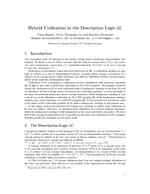LATPub541: Unterschied zwischen den Versionen
Aus International Center for Computational Logic
Marcel Lippmann (Diskussion | Beiträge) KKeine Bearbeitungszusammenfassung |
Marcel Lippmann (Diskussion | Beiträge) KKeine Bearbeitungszusammenfassung |
||
| (2 dazwischenliegende Versionen desselben Benutzers werden nicht angezeigt) | |||
| Zeile 6: | Zeile 6: | ||
{{Inproceedings | {{Inproceedings | ||
|Referiert=1 | |Referiert=1 | ||
|Title=Hybrid Unification in the Description Logic | |Title=Hybrid Unification in the Description Logic EL | ||
|Year=2013 | |Year=2013 | ||
|Month= | |Month= | ||
|Booktitle=Proceedings of the 27th International Workshop on Unification (UNIF'13) | |Booktitle=Proceedings of the 27th International Workshop on Unification (UNIF'13) | ||
|Editor=Barbara | |Editor=Barbara Morawska and Konstantin Korovin | ||
|Note= | |Note= | ||
|Organization= | |Organization= | ||
| Zeile 20: | Zeile 20: | ||
}} | }} | ||
{{Publikation Details | {{Publikation Details | ||
|Abstract=Unification in Description Logics (DLs) has been proposed as an inference | |Abstract=Unification in Description Logics (DLs) has been proposed as an inference service that can, for example, be used to detect redundancies in ontologies. For the DL EL, which is used to define several large biomedical ontologies, unification is NP-complete. However, the unification algorithms for EL developed until recently could not deal with ontologies containing general concept inclusions (GCIs). In a series of recent papers we have made some progress towards addressing this problem, but the ontologies the developed unification algorithms can deal with need to satisfy a certain cycle restriction. In the present paper, we follow a different approach. Instead of restricting the input ontologies, we generalize the notion of unifiers to so-called hybrid unifiers. Whereas classical unifiers can be viewed as acyclic TBoxes, hybrid unifiers are cyclic TBoxes, which are interpreted together with the ontology of the input using a hybrid semantics that combines fixpoint and descriptive semantics. We show that hybrid unification in EL is NP-complete. | ||
service that can, for example, be used to detect redundancies in ontologies. | |||
For the DL EL, which is used to define several large | |||
biomedical ontologies, unification is NP-complete. However, the unification algorithms for EL developed | |||
until recently could not deal with ontologies containing general concept inclusions (GCIs). | |||
In a series of recent papers we have made some progress towards addressing this problem, but the ontologies the | |||
developed unification algorithms can deal with need to satisfy a certain cycle restriction. | |||
In the present paper, we follow a different approach. | |||
we generalize the notion of unifiers to so-called hybrid unifiers. | |||
Whereas classical unifiers can be viewed as acyclic TBoxes, | |||
hybrid unifiers are cyclic TBoxes, which are interpreted together with the ontology of the input | |||
combines fixpoint and descriptive semantics. We show that hybrid unification in EL is NP-complete. | |||
|ISBN= | |ISBN= | ||
|ISSN= | |ISSN= | ||
| Zeile 49: | Zeile 37: | ||
year = {2013}, | year = {2013}, | ||
} | } | ||
}} | }} | ||
Aktuelle Version vom 25. März 2015, 16:34 Uhr
Hybrid Unification in the Description Logic EL
Franz BaaderFranz Baader, Oliver Fernández GilOliver Fernández Gil, Barbara MorawskaBarbara Morawska
Franz Baader, Oliver Fernández Gil, Barbara Morawska
Hybrid Unification in the Description Logic EL
In Barbara Morawska and Konstantin Korovin, eds., Proceedings of the 27th International Workshop on Unification (UNIF'13), 2013
Hybrid Unification in the Description Logic EL
In Barbara Morawska and Konstantin Korovin, eds., Proceedings of the 27th International Workshop on Unification (UNIF'13), 2013
- KurzfassungAbstract
Unification in Description Logics (DLs) has been proposed as an inference service that can, for example, be used to detect redundancies in ontologies. For the DL EL, which is used to define several large biomedical ontologies, unification is NP-complete. However, the unification algorithms for EL developed until recently could not deal with ontologies containing general concept inclusions (GCIs). In a series of recent papers we have made some progress towards addressing this problem, but the ontologies the developed unification algorithms can deal with need to satisfy a certain cycle restriction. In the present paper, we follow a different approach. Instead of restricting the input ontologies, we generalize the notion of unifiers to so-called hybrid unifiers. Whereas classical unifiers can be viewed as acyclic TBoxes, hybrid unifiers are cyclic TBoxes, which are interpreted together with the ontology of the input using a hybrid semantics that combines fixpoint and descriptive semantics. We show that hybrid unification in EL is NP-complete. - Forschungsgruppe:Research Group: AutomatentheorieAutomata Theory
@inproceedings{ BaBM-UNIF13,
address = {Eindhoven, The Netherlands},
author = {Franz {Baader} and Oliver {Fern\'andez Gil} and Barbara {Morawska}},
booktitle = {Proceedings of the 27th International Workshop on Unification (UNIF'13)},
editor = {Barbara {Morawska} and Konstantin {Korovin}},
title = {Hybrid Unification in the Description Logic {$\mathcal{EL}$}},
year = {2013},
}
